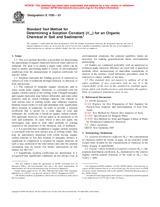Potřebujeme váš souhlas k využití jednotlivých dat, aby se vám mimo jiné mohly ukazovat informace týkající se vašich zájmů. Souhlas udělíte kliknutím na tlačítko „OK“.
ASTM E1195-01
Standard Test Method for Determining a Sorption Constant (Koc) for an Organic Chemical in Soil and Sediments
Automaticky přeložený název:
Standardní zkušební metoda pro stanovení sorpční konstanta ( KOC) pro organické chemie v půdě a sedimentech
NORMA vydána dne 10.10.2001
Informace o normě:
Označení normy: ASTM E1195-01
Poznámka: NEPLATNÁ
Datum vydání normy: 10.10.2001
Kód zboží: NS-40827
Počet stran: 8
Přibližná hmotnost: 24 g (0.05 liber)
Země: Americká technická norma
Kategorie: Technické normy ASTM
Anotace textu normy ASTM E1195-01 :
Keywords:
equilibrium sorption coefficients, partitioning of organic chemicals, sorption constant (Koc), ICS Number Code 13.080.10 (Chemical characteristics of soil)
Doplňující informace
| 1. Scope | ||||||||||
|
1.1 This test method describes a procedure for determining the partitioning of organic chemicals between water and soil or sediment. The goal is to obtain a single value which can be used to predict partitioning under a variety of environmental conditions from the measurement of sorption coefficients for specific solids. 1.2 Sorption represents the binding process of chemicals to surfaces of soils or sediments through chemical, or physical, or both interactions. 1.3 The sorption of nonpolar organic chemicals, and to some extent polar organic chemicals, is correlated with the organic carbon content of the sorbing solid. Charged inorganic and organic molecules may behave differently, and some other property, such as, cation exchange capacity, clay content, or total surface area of sorbing solids, may influence sorption. Hydrous metal oxides of iron and aluminum may significantly affect sorption in sediments. In order to provide a sorption coefficient that is useful for a wide range of soils and sediments, the coefficient is based on organic carbon content. This approach, however, will not apply to all chemicals or all soils and sediments. In cases where it does not apply, the investigator may need to seek other methods of relating sorption to the properties of the chemical, soil, or sediment. 1.4 It is possible that, in addition to organic carbon, sorption is correlated with the total surface area of sorbing solids. This may be particularly important with solids having organic carbon contents so low that sorption to inorganic surfaces is significant in comparison to sorption by organic material. In such a case, inclusion of the total surface area into the sorption calculation may be useful. For further information on this subject see Ref (1). 1.5 Equilibrium sorption coefficients are determined. It is recognized that equilibrium conditions do not always exist in environmental situations, but sorption equilibria values are necessary for making generalizations about environmental partitioning. 1.6 Studies are conducted preferably with an analytical or technical-grade chemical. Mixtures are used only if analytical methods allow measurement of individual components of interest in the mixture. Good laboratory procedures must be followed to ensure validity of the data. 1.7 This standard does not purport to address all of the safety problems, if any, associated with its use. It is the responsibility of the user of this standard to establish appropriate safety and health practices and determine the applicability of regulatory limitations prior to use.</p> |
||||||||||
| 2. Referenced Documents | ||||||||||
|
Odebírejte informace o nově vydaných normách ZDARMA:
Chcete pravidelně odebírat informace o nově vycházejících normách z celého světa a to zcela zdarma?
Přihlašte se k odběru. Vše je velice jednoduché a absolutně ZDARMA.
Na výběr máte vydavatele z celého světa.




 Cookies
Cookies
